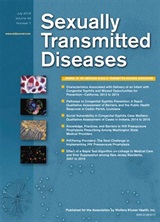Posted on May 28, 2021
Source: https://sti.bmj.com/content/97/3/226.long

Characterising HIV and STIs among transgender female sex workers: a longitudinal analysis
Summary: Having recently been arrested increased the risk of testing positive for a sexually transmitted infection by 77% among transgender female sex workers. Decriminalizing sex work and decreasing police profiling of transgender women may be an effective way to reduce sexually transmitted infections in this population.
Abstract:
"Objectives Though highly vulnerable to HIV and STIs, transgender female sex workers (TFSWs) are understudied in the US HIV and STI response. This study examined the correlates of laboratory-confirmed STIs among a cohort of 62 TFSWs followed over the course of 1 year and explored associations between specimen site and self-reported engagement in insertive and receptive anal intercourse.
Methods Participants completed an interviewer-administered computer-assisted personal interview at baseline, 3-, 6-, 9- and 12-month visits where self-administered anal swabs and urine samples for gonorrhea, chlamydia and trichomoniasis were also collected. HIV testing was conducted at baseline, 6-month and 12-month visits.
Results Baseline HIV prevalence was 40.3% with no HIV seroconversions over follow-up. Baseline prevalence of gonorrhea, chlamydia and trichomoniasis was 9.7%, 17.7% and 14.5%, respectively. In the multivariable regression modelling, recent arrest was significantly associated with testing positive for any STI (adjusted risk ratio (RR) 1.77; 95% CI: 1.10 to 2.84). Insertive anal sex with clients was associated with increased risk of testing positive for an STI via urine specimen (RR 3.48; 95% CI: 1.14 to 10.62), while receptive anal sex was not significantly associated with specimen site.
Conclusion Our findings confirm a high prevalence of STIs among TFSWs and highlight the importance of addressing structural drivers such as criminal justice involvement as well as the need to ensure screening for STIs at all anatomical sites regardless of self-reported sites of potential exposure. More research is needed to better understand HIV and STI vulnerabilities and appropriate interventions for TFSWs in the USA."